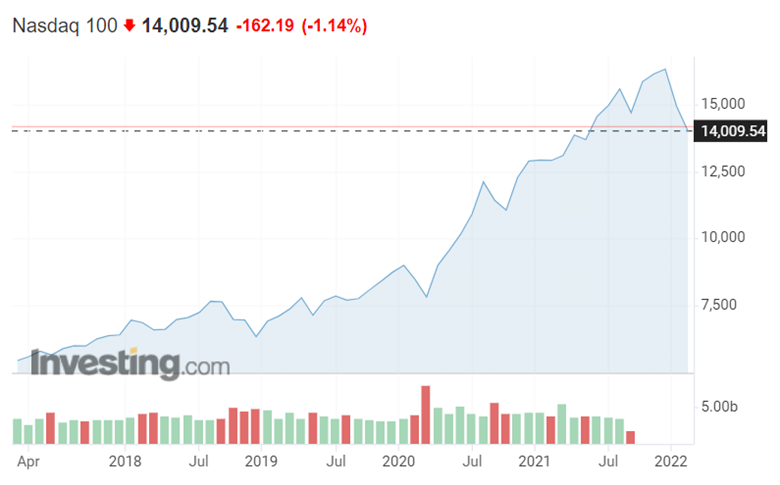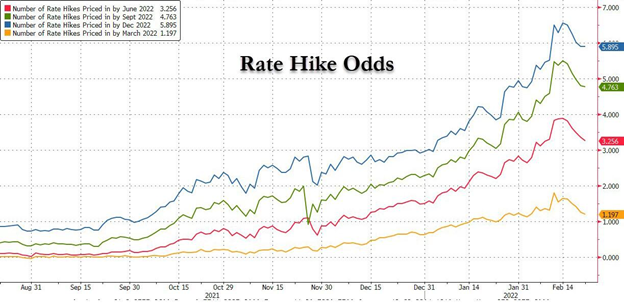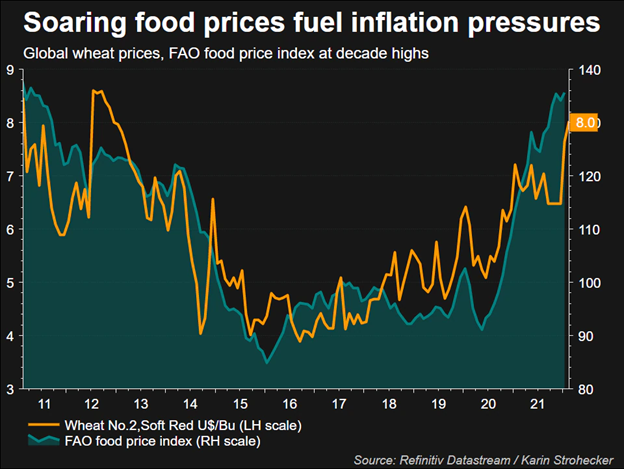Short term macro image exuding uncertainty


The stock market has been in turmoil since the beginning of the year due to inflation fears and geopolitical instability.
The stock market has been in turmoil since the beginning of the year due to inflation fears and geopolitical instability.
The five-year chart shows a sharp rise in technology stocks, but the early part of the year has been difficult for the Nasdaq 100 index. The return on the index this year is 15 percent in the negative.

The measures taken by the central bank Fed to raise the key interest rate have hit tech stocks in particular, but the indices have not fared much better. The comprehensive S&P500 index is also down nearly 10 percent this year.
Shares of the German DAX index have not outperformed their American benchmarks in five years and the DAX is also down 10 percent this year.

The mood in the market is less bright than before in response to inflation, central bank monetary policy, the Russia-Ukraine crisis and supply chain problems caused by the pandemic.
In the following, let's examine what a macro image looks like at the moment and what products can be used to trade a macro view with different indexes.
Central Bank Monetary Policy
Market participants are feverishly considering how many times the US Federal Reserve intends to raise its key interest rate this year.
At the beginning of the year, the financial media have been able to read bets on six or seven interest rate tightenings. Last week, investment bank JPMorgan predicted as many as nine consecutive rate hikes of 0.25 percent, which would mean one rate hike at all Fed meetings this year.
At the same time, FED Funds interest rate futures are already pricing two interest rate cuts for 2024 (black line), although the expectations of Fed decision-makers are much higher than this (yellow balls).

Thanks to the Russia-Ukraine conflict, the price of oil could rise further, putting sticks in the wheel of global economic growth.
The currency and bond strategist at SMBC Nikko Securities, Makoto Noji believes the market is slowly pricing in two percent interest rates set by the FED.The strategist believes this would be enough to keep inflation in check. “A deeper correction in equities would raise the savings rate for U.S. households, curb consumption and discourage inflation,” Noji writes according to the Bloomberg article.
According to Noji, the Fed does not have to be dovish to support stock prices. “The central bank is very likely to raise interest rates in March and will rethink the situation after March,” Noji believes.
According to SBMC’s analysis, the surest way to a global recession is an economic shock that would send the price of oil into the clouds. The recession is also likely to bring with it a further stimulus from central banks, which has historically supported stock prices.
JPMorgan’s Marko Kolanovic also believes the situation in Ukraine will influence the Fed's decisions: "Although the risk of conflict in Ukraine is high, it should have a limited impact on global stock markets and would likely trigger a pigeon reassessment from central banks."
The market has already reacted to the situation by swap traders. Indexed swaps predict a 19 percent probability of a 0.5 percent interest rate hike in March, up from 56 percent a week ago. The probabilities have been steadily declining in February due to geopolitical risks.
The swap market forecasts six rate hikes to 1.50 percent this year.

Measures taken by central banks also have a broad impact on share prices. In general, loose monetary policy (low interest rates, stimulus) supports stock prices, while tight monetary policy (rising interest rates, shrinking central bank balance sheets) has historically had a more difficult time for equities.
If you believe Nasdaq will recover from its losses at the beginning of the year and start a new rise, you participate in returns with Vontobel's Turbo Long TLNG NDX V134. At the time of writing, the Turbo offers a 9.69-fold leverage, boosting the performance of the underlying Nasdaq 100 Index. If the Nasdaq rises by one percent, the value of the Turbo will rise by 9.69 percent. If Nasdaq, on the other hand, drops one percent, Turbo will make a 9.69 percent loss.
If you believe the difficult year for Nasdaq will continue, you can trade in Vontobel 's TSRT NDX V162 Turbo Short. Its value will rise by 6.04 percent as the Nasdaq index falls by one percent. Its leverage is thus 6.04 times and it also amplifies the Turbo's losses; the value of the Turbo will fall by 6.04 percent as the Nasdaq index rises by one percent.
Impact of the situation in Russia and Ukraine on different world markets
Russia's potential military measures against Ukraine are likely to affect a wide range of markets, from equities to commodities, currencies and bonds.
Reuters listed five markets that would be affected by the conflict.
Safe havens
A major risk event generally drives investors to safer investments, historically bonds have been considered one of the safest investments.
Inflation is at its peak in decades, with the US 10-year Boni at around 2 per cent and the German 10-year bond for the first time since 2019 at over 0 per cent. However, the conflict in Ukraine could change the situation.
Gold, on the other hand, is at its peak in 13 months.

Agricultural commodities
Ukraine, Russia, Kazakhstan and Romania are all major exporters of grain and all major ports are located in the Black Sea. Military action in the region could potentially disrupt the grain supply chain.
Ukraine is expected to be the world's third largest exporter of corn and the third largest exporter of wheat in the period 2021-2022. Russia is the largest exporter of wheat.
The price of wheat has been rising steadily and has bounced sharply since the beginning of the year.

Natural gas and oil
The energy market could experience disturbance if tensions escalate into conflict. Russia produces 35% of Europe's natural gas, some of which comes through Ukraine.
Germany has threatened Russia with the suspension of the new Nord Stream 2 natural gas pipeline if Russia poses an armed threat to Ukraine.
Analysts expect natural gas imports to Europe to shrink significantly if the situation in Ukraine escalates.
According to JPMorgan, tensions in the situation in Ukraine pose a significant risk to rising oil prices. The investment bank believes the $150 oil price will reduce global annual GDP growth to just 0.9 per cent in the first half of the year, while raising inflation to 7.2 per cent.
The price of natural gas peaked in December.
Read an article on trading natural gas and oil with Vontobel's lever products.
Equities
Western equities could come under pressure due to potential conflict.
Of the German stocks, bank stocks in particular could have an impact on their skins. German banks have 8.8 billion in loans to Russia, according to BIS.
Other German sectors also have contact with the Russian market: Metro AG's 93 stores in Russia generate just under 10% of the company's sales.
According to Reuters, banks are under the most pressure in the crisis in Ukraine.
Currencies and bonds
Both Russian and Ukrainian dollar-denominated bonds have performed worse than their comparisons in recent months as tensions have risen.
Uncertainty in all markets is also reflected in equities, and the German DAX index is no exception. You can trade at DAX with Vontobel certificates.
You can participate in the movements of DAX-index with the BULL DAX X20V1 certificate. It reinforces DAX’s intraday movements with a 20-fold leverage. If the price of DAX increases by one percent, the value of the certificate increases by 20 percent. Correspondingly, when the DAX index decreases by one percent, the certificate produces a 20 percent loss.
BEAR DAX X12 V18 certificate, in turn, returns profits if the DAX index price goes down. If the DAX decreases by one percent, the certificate yields a 12 percent profit. If the DAX rises by one percent contrary to expectations, the loss on the certificate will be 12 percent.
Vontobel's mini-futures
MFL ETH V24
will yield profit as the ether future price rises. It offers a 2.61-fold leverage when writing an article on ether future, meaning the mini-future yields 2.61 percent when the price of ether futures goes up by one percent. Correspondingly, with the price of ether futures falling by one per cent, the mini-future will produce a loss of 2.61 per cent.
The MFS ETH V54 mini-futures allows you to pursue returns as the price of an ether futures drops. If the price of an ether futures falls by one percent, the value of the mini-futures rises by 3.43 percent. In other words, the leverage of that mini-future is 3.43 times. If the price of the ether futures goes up by one per cent, the loss for the mini-future will be 3.43 per cent.
Risks
This information is neither an investment advice nor an investment or investment strategy recommendation, but advertisement. The complete information on the securities, in particular the structure and risks associated with an investment, are described in the base prospectus, together with any supplements, as well as the final terms. It is recommended that potential investors read these documents before making any investment decision. The documents and the key information document are published on the website of the issuer, Vontobel Financial Products GmbH, Bockenheimer Landstrasse 24, 60323 Frankfurt am Main, Germany, on prospectus.vontobel.com and are available from the issuer free of charge. The approval of the prospectus should not be understood as an endorsement of the securities. The securities are products that are not simple and may be difficult to understand. Past performance is not a reliable indicator of future performance.